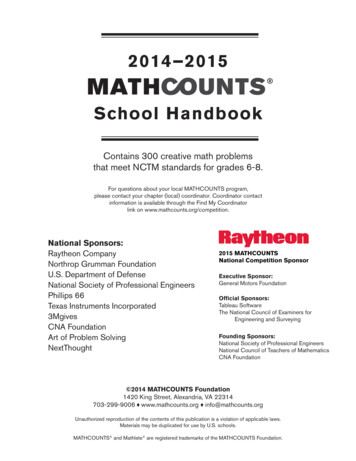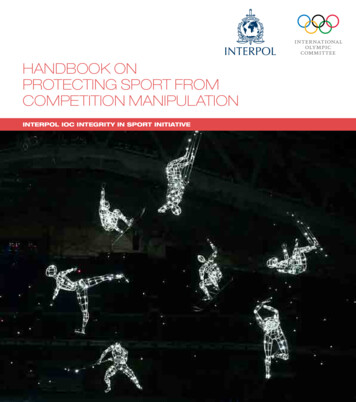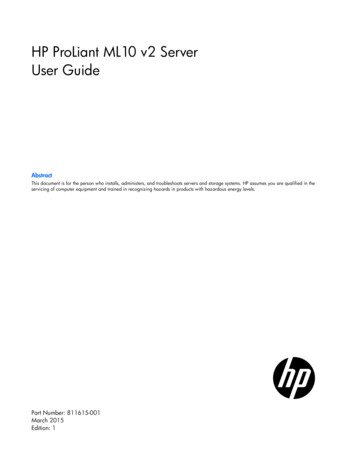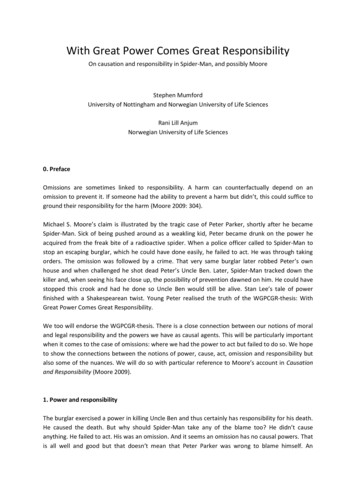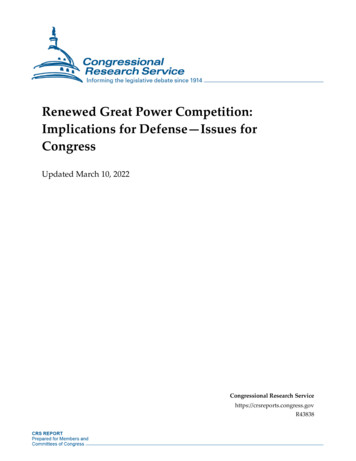
Transcription
Renewed Great Power Competition:Implications for Defense—Issues forCongressUpdated March 10, 2022Congressional Research Servicehttps://crsreports.congress.govR43838
Renewed Great Power Competition: Implications for Defense—Issues for CongressSummaryThe emergence of great power competition with China and Russia over the past several years, andthe underscoring of that development for some observers by Russia’s invasion of Ukrainebeginning in late February 2022, have profoundly changed the conversation about U.S. defenseissues from what it was during the post-Cold War era: Counterterrorist operations and U.S.military operations in the Middle East—which had been more at the center of discussions of U.S.defense issues following the terrorist attacks of September 11, 2001—are now a less-prominentelement in the conversation, and the conversation now features a new or renewed emphasis on thefollowing, all of which relate to China and/or Russia: grand strategy and the geopolitics of great power competition as a starting pointfor discussing U.S. defense issues;organizational changes within DOD;nuclear weapons, nuclear deterrence, and nuclear arms control;global U.S. military posture;U.S. and allied military capabilities in the Indo-Pacific region;U.S. and NATO military capabilities in Europe;new U.S. military service operational concepts;capabilities for conducting so-called high-end conventional warfare;maintaining U.S. superiority in conventional weapon technologies;innovation and speed of U.S. weapon system development and deployment;mobilization capabilities for an extended-length large-scale conflict;supply chain security, meaning awareness and minimization of reliance in U.S.military systems on foreign components, subcomponents, materials, andsoftware; andcapabilities for countering so-called hybrid warfare and gray-zone tactics.In connection with some of the above-listed topics, Russia’s invasion of Ukraine beginning in lateFebruary 2022 has become an additional factor in the discussion regarding the future size of theU.S. defense budget.The issue for Congress is how U.S. defense planning should respond to the emergence of greatpower competition with China and Russia, and whether to approve, reject, or modify the BidenAdministration’s proposed defense funding levels, strategy, plans, and programs for addressinggreat power competition. Congress’s decisions on these issues could have significant implicationsfor U.S. defense capabilities and funding requirements.Congressional Research Service
Renewed Great Power Competition: Implications for Defense—Issues for CongressContentsIntroduction . 1Background . 1Shift to Renewed Great Power Competition . 1Overview . 1Alternate Term: Strategic Competition . 3Overview of Implications for Defense . 4Grand Strategy and Geopolitics of Great Power Competition . 4Organizational Changes within DOD . 5Nuclear Weapons, Nuclear Deterrence, and Nuclear Arms Control . 6Global U.S. Military Posture . 8U.S. and Allied Capabilities in Indo-Pacific Region . 14U.S. and NATO Capabilities in Europe . 16New Operational Concepts . 17Capabilities for High-End Conventional Warfare . 18Maintaining U.S. Superiority in Conventional Weapon Technologies . 19Innovation and Speed of U.S. Weapon System Development and Deployment . 20Mobilization Capabilities for Extended-Length Conflict . 22Supply Chain Security . 24Capabilities for Countering Hybrid Warfare and Gray-Zone Tactics . 25Issues for Congress . 25AppendixesAppendix A. Shift from Post-Cold War Era to Renewed Great Power Competition . 29Appendix B. Articles on Shift to Renewed Great Power Competition. 36Appendix C. Articles on Grand Strategy and Geopolitics . 45Appendix D. Readings on Supply Chain Security . 57Appendix E. Articles on Russian and Chinse Irregular, Hybrid, and Gray-Zone Warfare . 62Appendix F. Congress and the Late 1980s/Early 1990s Shift to Post-Cold War Era . 71ContactsAuthor Information. 73Congressional Research Service
Renewed Great Power Competition: Implications for Defense—Issues for CongressIntroductionThis report provides a brief overview of implications for U.S. defense of the emergence of greatpower competition with China and Russia. The issue for Congress is how U.S. defense planningshould respond to the renewal of great power competition, and whether to approve, reject, ormodify the Biden Administration’s proposed defense funding levels, strategy, plans, andprograms for addressing great power competition. Congress’s decisions on these issues couldhave significant implications for U.S. defense capabilities and funding requirements.This report focuses on defense-related issues and does not discuss potential implications of therenewal of great power competition for other policy areas, such as foreign policy and diplomacy,trade and finance, energy, and foreign assistance.BackgroundShift to Renewed Great Power CompetitionOverviewThe post-Cold War era of international relations—which began in the early 1990s, following theend of the Cold War between the United States and the Soviet Union, and which is sometimesreferred to as the unipolar moment (with the United States as the unipolar power)—showed initialsigns of fading in 2006-2008, and by 2014 had given way to a fundamentally different situationof great power competition with China and Russia and challenges by these two countries andothers to elements of the U.S.-led international order that has operated since World War II.1 Forsome observers, the ending of the post-Cold War era and the shift to an era of great powercompetition and challenges by China and Russia to the post-World War II U.S.-led internationalorder has been underscored by the increased strategic partnership (some observers use terms suchas alignment, convergence, or alliance) between China and Russia, particularly since the start of2022, and by Russia’s invasion of Ukraine beginning in late February 2022.2The renewal of great power competition was acknowledged alongside other considerations in theObama Administration’s June 2015 National Military Strategy.3 It was placed at the center of theTrump Administration’s December 2017 National Security Strategy (NSS)4 and January 20181For further discussion, see Appendix A. The term international order is generally used to refer to the collection oforganizations, institutions, treaties, rules, and norms that are intended to organize, structure, and regulate internationalrelations during a given historical period. Key features of the U.S.-led international order established at the end ofWorld War II—also known as the liberal international order, postwar international order, or open international order,and often referred to as a rules-based order—are generally said to include the following: respect for the territorialintegrity of countries, and the unacceptability of changing international borders by force or coercion; a preference forresolving disputes between countries peacefully, without the use or threat of use of force or coercion; stronginternational institutions; respect for international law and human rights; a preference for free markets and free trade;and the treatment of international waters, international air space, outer space, and (more recently) cyberspace asinternational commons. For additional discussion, see CRS Report R44891, U.S. Role in the World: Background andIssues for Congress, by Ronald O'Rourke and Michael Moodie.2 See, for example, some of the articles dated from late February 2022 into March 2022 that are listed in Appendix B.3 Department of Defense, The National Military Strategy of the United States of America 2015, The United StatesMilitary’s Contribution To National Security, June 2015, pp. i, 1-4.4 Office of the President, National Security Strategy of the United States of America, December 2017, 55 pp.Congressional Research Service1
Renewed Great Power Competition: Implications for Defense—Issues for CongressNational Defense Strategy (NDS),5 which formally reoriented U.S. national security strategy andU.S. defense strategy toward an explicit primary focus on great power competition with Chinaand Russia.The Biden Administration’s March 2021 Interim National Security Strategy Guidance states that“we face a world of rising nationalism, receding democracy, growing rivalry with China, Russia,and other authoritarian states, and a technological revolution that is reshaping every aspect of ourlives,” and that protecting the security of the American people “requires us to meet challenges notonly from great powers and regional adversaries, but also from violent and criminal non-stateactors and extremists, and from threats like climate change, infectious disease, cyberattacks, anddisinformation that respect no national borders.”6 The document further states (emphasis as inoriginal)We must also contend with the reality that the distribution of power across the world ischanging, creating new threats. China, in particular, has rapidly become more assertive.It is the only competitor potentially capable of combining its economic, diplomatic,military, and technological power to mount a sustained challenge to a stable and openinternational system. Russia remains determined to enhance its global influence and play adisruptive role on the world stage. Both Beijing and Moscow have invested heavily inefforts meant to check U.S. strengths and prevent us from defending our interests and alliesaround the world. Regional actors like Iran and North Korea continue to pursue gamechanging capabilities and technologies, while threatening U.S. allies and partners andchallenging regional stability. We also face challenges within countries whose governanceis fragile, and from influential non-state actors that have the ability to disrupt Americaninterests. Terrorism and violent extremism, both domestic and international, remainsignificant threats. But, despite these steep challenges, the United States’ enduringadvantages—across all forms and dimensions of our power—enable us to shape the futureof international politics to advance our interests and values, and create a freer, safer, andmore prosperous world .Defending America also means setting clear priorities within our defense budget. First andforemost, we will continue to invest in the people who serve in our all-volunteer force andtheir families. We will sustain readiness and ensure that the U.S. Armed Forces remain thebest trained and equipped force in the world. In the face of strategic challenges from anincreasingly assertive China and destabilizing Russia, we will assess the appropriatestructure, capabilities, and sizing of the force, and, working with the Congress, shift ouremphasis from unneeded legacy platforms and weapons systems to free up resources forinvestments in the cutting-edge technologies and capabilities that will determine ourmilitary and national security advantage in the future. We will streamline the processes fordeveloping, testing, acquiring, deploying, and securing these technologies. We will ensurethat we have the skilled workforce to acquire, integrate, and operate them. And we willshape ethical and normative frameworks to ensure these technologies are used responsibly.We will maintain the proficiency of special operations forces to focus on crisis responseand priority counterterrorism and unconventional warfare missions. And we will developcapabilities to better compete and deter gray zone actions. We will prioritize defenseinvestments in climate resiliency and clean energy. And we will work to ensure that theDepartment of Defense is a place of truly equal opportunity where our service members donot face discrimination or the scourge of sexual harassment and assault .Taken together, this agenda will strengthen our enduring advantages, and allow us toprevail in strategic competition with China or any other nation. The most effective way for5Department of Defense, Summary of the 2018 National Defense Strategy of the United States of America: Sharpeningthe American Military’s Competitive Edge, undated but released January 2018, 11 pp.6 White House, Interim National Security Strategic Guidance, March 2021, pp. 6, 9.Congressional Research Service2
Renewed Great Power Competition: Implications for Defense—Issues for CongressAmerica to out-compete a more assertive and authoritarian China over the long-term is toinvest in our people, our economy, and our democracy. By restoring U.S. credibility andreasserting forward-looking global leadership, we will ensure that America, not China, setsthe international agenda, working alongside others to shape new global norms andagreements that advance our interests and reflect our values. By bolstering and defendingour unparalleled network of allies and partners, and making smart defense investments, wewill also deter Chinese aggression and counter threats to our collective security, prosperity,and democratic way of life.At the same time, revitalizing our core strengths is necessary but not sufficient. In manyareas, China’s leaders seek unfair advantages, behave aggressively and coercively, andundermine the rules and values at the heart of an open and stable international system.When the Chinese government’s behavior directly threatens our interests and values, wewill answer Beijing’s challenge.7Department of Defense (DOD) officials have identified countering China’s military capabilitiesas DOD’s top priority.8 They have described Russia a major additional defense-planning priority,particularly with regard to certain specific defense-planning concerns, such as strategic nuclearweapons, the military balance in Europe, and Russian military capabilities (such as electronicwarfare and submarines, to cite two examples) where Russia is considered by DOD officials to bea technological pacing challenge or threat for the United States.Alternate Term: Strategic CompetitionAn October 5, 2021, press report statesGoodbye, “great power competition.” Hello, “strategic competition.”A Defense Department spokesperson confirmed to our own Daniel Lippman and LaraSeligman that the Pentagon will use the new phrase to describe its approach towardChina—explicitly moving away from the Trump-era framework.“Strategic competition” aligns more closely with the administration’s thinking on China.The DOD spokesperson, Lt. Col. Martin Meiners, noted how the White House’s InterimNational Security Strategic Guidance specifically refers to “strategic competition withChina or any other nation.”.7White House, Interim National Security Strategic Guidance, March 2021, pp. 7-8, 14-15, 20. For more on thedocument, see CRS In Focus IF11798, The Interim National Security Strategic Guidance, by Kathleen J. McInnis.8 See, for example, Mike Glenn, “U.S. Military Peeks Into the Future to See Its Most Daunting Threat: China,”Washington Times, September 16, 2020; Mark Esper, “The Pentagon Is Prepared for China,” Wall Street Journal,August 24, 2020; Abraham Mahshie, “Mark Esper Details ‘Vigorous’ Defense Department Reorientation to ConfrontChina’s Rise,” Washington Examiner, August 5, 2020; Bill Gertz, “Pentagon: China Threat Increasing,” WashingtonTimes, February 26, 2020; Tom Rogan, “Defense Secretary Mark Esper: It’s China, China, China,” WashingtonExaminer, August 28, 2019; Melissa Leon and Jennifer Griffin, “Pentagon ‘Very Carefully’ Watching China, It’s ‘No.1 Priority,’ Defense Secretary Mark Esper Tells Fox News,” Fox News, August 22, 2019; Missy Ryan and DanLamothe, “Defense Secretary Wants to Deliver on the Goal of Outpacing China. Can He Do It?” Washington Post,August 6, 2019; Sandra Erwin, “New Pentagon Chief Shanahan Urges Focus on China and ‘Great PowerCompetition,’” Space News, January 2, 2019; Ryan Browne, “New Acting Secretary of Defense Tells Pentagon ‘toRemember China, China, China,’” CNN, January 2, 2019; Paul McCleary, “Acting SecDef Shanahan’s First Message:‘China, China, China,’” Breaking Defense, January 2, 2019.For more on China’s military modernization effort, see CRS Report R46808, China’s Military: The People’sLiberation Army (PLA), by Caitlin Campbell; and CRS Report RL33153, China Naval Modernization: Implications forU.S. Navy Capabilities—Background and Issues for Congress, by Ronald O'RourkeCongressional Research Service3
Renewed Great Power Competition: Implications for Defense—Issues for CongressBut “strategic competition” as a phrase isn’t new: the Trump administration even used itin its 2018 National Defense Strategy.9For additional background information and a list of articles on the shift from the post-Cold Warera to renewed great power competition, see Appendix A and Appendix B.Overview of Implications for DefenseThe emergence of great power competition with China and Russia has profoundly changed theconversation about U.S. defense issues from what it was during the post-Cold War era:Counterterrorist operations and U.S. military operations in the Middle East—which had beenmore at the center of discussions of U.S. defense issues following the terrorist attacks ofSeptember 11, 2001—are now a less-prominent element in the conversation, and the conversationnow features a new or renewed emphasis on the topics discussed briefly in the sections below, allof which relate to China and/or Russia. In connection with some of these topics, Russia’sinvasion of Ukraine beginning in late February 2022 has become an additional factor in thediscussion regarding the future size of the U.S. defense budget.Grand Strategy and Geopolitics of Great Power CompetitionThe renewal of great power competition has led to a renewed emphasis on grand strategy10 andthe geopolitics11 of great power competition as a starting point for discussing U.S. defensefunding levels, strategy, plans, and programs. A November 2, 2015, press report, for example,stated the following:The resurgence of Russia and the continued rise of China have created a new period ofgreat-power rivalry—and a corresponding need for a solid grand strategy, [then-]U.S.Deputy Defense Secretary Robert Work said Monday at the Defense One Summit inWashington, DC.“The era of everything [i.e., multiple international security challenges] is the era of grandstrategy,” Work said, suggesting that the United States must carefully marshal and deployits great yet limited resources. 12For the United States, grand strategy can be viewed as strategy at a global or interregional level,as opposed to U.S. strategies for individual regions, countries, or issues. From a U.S. perspectiveDaniel Lippman, Lara Seligman, Alexander Ward, and Quint Forgey, “Biden’s Era of ‘Strategic Competition,’”Politico, October 5, 2021. See also Cornell Overfield, “Biden’s ‘Strategic Competition’ Is a Step Back,” ForeignPolicy, October 13, 2021; Harlan Ullman and Arnaud de Borchgrave, “Great Power Competition with Russia, China Isa Fallacy,” United Press International, October 13, 2021; Becca Wasser, “Why the Pentagon Should Abandon‘Strategic Competition,’” Foreign Policy, October 19, 2021.10 The term grand strategy generally refers to a country’s overall strategy for securing its interests and making its wayin the world, using all the national tools at its disposal, including diplomatic, information, military, and economic tools(sometimes abbreviated in U.S. government parlance as DIME).11 The term geopolitics is often used as a synonym for international politics or strategy relating to international politics.More specifically, it refers to the influence of basic geographic features on international relations, and to the analysis ofinternational relations from a perspective that places a strong emphasis on the influence of such geographic features.Basic geographic features involved in geopolitical analysis include things such as the relative sizes and locations ofcountries or land masses; the locations of key resources such as oil or water; geographic barriers such as oceans,deserts, and mountain ranges; and key transportation links such as roads, railways, and waterways. For furtherdiscussion, see Daniel H. Deudney, “Geopolitics,” Encyclopedia Britannica, June 12, 2013, accessed November 17,2021, at https://www.britannica.com/topic/geopolitics.12 Bradley Peniston, “Work: ‘The Age of Everything Is the Era of Grand Strategy’,” Defense One, November 2, 2015.9Congressional Research Service4
Renewed Great Power Competition: Implications for Defense—Issues for Congresson grand strategy and geopolitics, it can be noted that most of the world’s people, resources, andeconomic activity are located not in the Western Hemisphere, but in the other hemisphere,particularly Eurasia. In response to this basic feature of world geography, U.S. policymakers forthe last several decades have chosen to pursue, as a key element of U.S. national strategy, a goalof preventing the emergence of regional hegemons in Eurasia. Although U.S. policymakers do notoften state explicitly in public the goal of preventing the emergence of regional hegemons inEurasia, U.S. military operations in recent decades—both wartime operations and day-to-dayoperations—appear to have been carried out in no small part in support of this goal.The goal of preventing the emergence of regional hegemons in Eurasia is a major reason why theU.S. military is structured with force elements that enable it to deploy from the United States,cross broad expanses of ocean and air space, and then conduct sustained, large-scale militaryoperations upon arrival in Eurasia or the waters and airspace surrounding Eurasia. Force elementsassociated with this goal include, among other things, an Air Force with significant numbers oflong-range bombers, long-range surveillance aircraft, long-range airlift aircraft, and aerialrefueling tankers, and a Navy with significant numbers of aircraft carriers, nuclear-poweredattack submarines, large surface combatants, large amphibious ships, and underwayreplenishment ships.13The U.S. goal of preventing the emergence of regional hegemons in Eurasia, though longstanding, is not written in stone—it is a policy choice reflecting two judgments: (1) that given theamount of people, resources, and economic activity in Eurasia, a regional hegemon in Eurasiawould represent a concentration of power large enough to be able to threaten vital U.S. interests;and (2) that Eurasia is not dependably self-regulating in terms of preventing the emergence ofregional hegemons, meaning that the countries of Eurasia cannot be counted on to be able toprevent, though their own actions, the emergence of regional hegemons, and may need assistancefrom one or more countries outside Eurasia to be able to do this dependably.A renewal of great power competition does not axiomatically require an acceptance of both ofthese judgments as guideposts for U.S. defense in coming years—one might accept that there hasbeen a renewal of great power competition, but nevertheless conclude that one of these judgmentsor the other, while perhaps valid in the past, is no longer valid. A conclusion that one of thesejudgments is no longer valid could lead to a potentially major change in U.S. grand strategy thatcould lead to large-scale changes in U.S. defense funding levels, strategy, plans, and programs.By the same token, a renewal of great power competition does not by itself suggest that these twojudgements—and the consequent U.S. goal of preventing the emergence of regional hegemons inEurasia—are not valid as guideposts for U.S. defense in coming years.For a list of articles pertaining to the debate over U.S. grand strategy, see Appendix C.Organizational Changes within DODThe renewal of great power competition has led to increased discussion about whether and how tomake organizational changes within DOD to better align DOD’s activities with those needed tocounter Chinese and, secondarily, Russian military capabilities. Among changes that have beenmade, among the most prominent have been the creation of the U.S. Space Force14 and theelevation of the U.S. Cyber Command to be its own combatant command.1513For additional discussion, see CRS In Focus IF10485, Defense Primer: Geography, Strategy, and U.S. Force Design,by Ronald O'Rourke.14 See CRS In Focus IF11495, Defense Primer: The United States Space Force, by Stephen M. McCall.15 See CRS In Focus IF10537, Defense Primer: Cyberspace Operations, by Catherine A. Theohary.Congressional Research Service5
Renewed Great Power Competition: Implications for Defense—Issues for CongressNuclear Weapons, Nuclear Deterrence, and Nuclear Arms ControlThe renewal of great power competition has led to a renewed emphasis in discussions of U.S.defense on nuclear weapons, nuclear deterrence, and nuclear arms control. Russia’s reassertion ofits status as a major world power has included, among other things, recurring references byRussian officials to Russia’s nuclear weapons capabilities and Russia’s status as a major nuclearweapon power. At the end of February 2022, during its invasion of Ukraine, Russia announcedthat it was increasing the alert level of its nuclear forces.16 China’s nuclear-weapon capabilitiesare currently much more modest than Russia’s, but China reportedly is now modernizing andrapidly increasing its nuclear forces as part of its overall military modernization effort.The increased emphasis in discussions of U.S. defense and security on nuclear weapons, nucleardeterrence, and nuclear arms control comes at a time when DOD is in the early stages of amultiyear plan to spend scores of billions of dollars to modernize U.S. strategic nuclear deterrentforces.17 DOD, for example, currently has plans to acquire a new class of ballistic missilesubmarines18 and a next-generation long-range bomber.19Regarding nuclear arms control,20 the topic of nuclear weapons in a context of great powercompetition with Russia and China was a key factor in connection with the U.S. decision towithdraw from the Intermediate-Range Nuclear Forces (INF) Treaty.21 The Trump Administrationinvited China to be a third participant, along with the United States and Russia, in negotiations onSee, for example, Yuras Karmanau, Jim Heintz, Vladimir Isachenkov, and Dasha Litvinova, “Putin Puts NuclearForces on High Alert, Escalating Tensions,” Associated Press, February 27, 2022; Isabelle Khurshudyan, DrewHarwell, Robyn Dixon, and Miriam Berger, “Putin Puts Russian Nuclear Forces on Alert as Ukrainian Civilian DeathsMount,” Washington Post, February 27, 2022; Hal Brands, “Putin Reminds Biden That Nuclear Deterrence Works,”Bloomberg, March 2, 2022; Fred Lucas and Patty-Jane Geller, “Answers to 6 Big Questions About Putin’s NuclearThreats,” Heritage Foundation, March 3, 2022; Azriel Bermant and Wyn Rees, “We Need to Talk About NuclearWeapons Again, Vladimir Putin’s Nuclear Threats Plunge the West into a Debate It’s Not Ready For,” Foreign Policy,March 7, 2022; Bryan Bender, “‘Crisis dynamics’ Forcing a Rethink of Nuclear Deterrence, Top Commander Says,Russia’s Invasion of Ukraine Has Highlighted Moscow's Willingness to Threaten the Use of Nuclear Weapons,”Politico Pro, March 8, 2022.17See CRS Report RL33640, U.S. Strategic Nuclear Forces: Background, Developments, and Issues, by Amy F.Woolf, and Congressional Budget Office, Projected Costs of U.S. Nuclear Forces, 2021 to 2030, May 2021, 12 pp.18 CRS Report R41129, Navy Columbia (SSBN-826) Class Ballistic Missile Submarine Program: Background andIssues for Congress, by Ronald O'Rourke.19 See CRS Report R44463, Air Force B-21 Raider Long-Range Strike Bomber, by Jeremiah Gertler.20 For discussions on arms control in the context of great power competition, see, for example, Rebecca K.C. Hersman,Heather Williams, and Suzanne Claeys, Integrated Arms Control in an Era of Strategic Competition, Center forStrategic and International Studies (CSIS), January 2022, 65 pp.; Jeffrey Lewis, “China Is Radically Expanding ItsNuclear Missile Silos, With More Weapons Likely, It’s Time to Go Back to Arms Talks,” Foreign Policy, June 30,2021; John Maurer, “Arms Control Among Rivals,” American Enterprise Institute, February 11, 2021.21 For additional discussion, see CRS Insight
power competition with China and Russia. The issue for Congress is how U.S. defense planning should respond to the renewal of great power competition, and whether to approve, reject, or modify the Biden Administration’s proposed defense funding levels, strategy, plans, and programs



